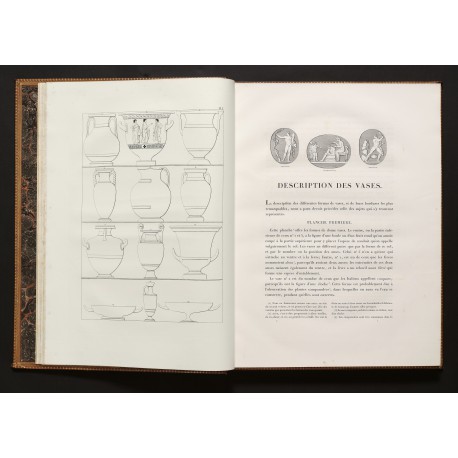Peintures antiques et inédites de vases grecs, tirées de diverses collections, avec des explications, par J.V. Millingen
- Subjects
- Archaeology, Greek & Roman
- Art - Collectors and collecting - Italian collections, 19th century
- Vase-painting, Greek
- Authors/Creators
- Millingen, James, 1774-1845
- Artists/Illustrators
- Giangiacomo, Francesco, 1782-1864
- Steurnal, Michele, active 1813
- Printers/Publishers
- De Romanis, Mariano, active 1789?-1824?
Millingen, James
London 1774 – 1845 Florence
Peintures antiques et inédites de vases grecs, tirées de diverses collections, avec des explications, par J.V. Millingen.
Rome, Imprimé Par [Mariano] De Romanis, 1813
broadsheet folio (530 × 364 mm), (55) ff. letterpress, signed π1 (half-title, Peintures de Vases Grecs) (A)1 (title) B–H1 1–421 a–d1 (index) and paginated (4) i–xiii (1), 1–84 i–viii; plus sixty-three engraved plates numbered i–lx, a–c, of which seven are double-page (nos. 4, 5, 36–37, 49–50, 57).
bound in contemporary russia leather, decorated in gilt.
First edition of a catalogue of vases mostly found in Italian private collections, including those belonging to the author;1 Giuseppe Capecelatro, Archbishop Emeritus of Taranto;2 Francesco Carelli, secretary of the Accademia Ercolanese;3 Raffaele Gargiulo, dealer and restorer of vases;4 Onorato Gaetani, duca di Miranda;5 ‘Monseigneur l’Evêque de Nola’;6 Onofrio Pacileo, antiquary and dealer in Naples;7 ‘M. de Soisson, Secrétaire des Dépenses de S. M. la Reine de Naples, et amateur éclairé des beaux-arts’;8 ‘M. le Prince della Tor[r]ella à Naples’;9 ‘Son Exe. M. le Comte [Giuseppe] Zurlo, Ministre de l’Intérieur à Naples’;10 and Carolina Murat, queen of Naples.11

Millingen was ‘the first to point out the domestic nature of these vases, and the introduction contains an account of their various uses’.12 The vases are classified according to period (following Winckelmann’s broad divisions) and reproduced with unprecedented care and fidelity; the plates lettered a–c show the variety of shapes of vases. Millingen warns of the fraudulent restorations perpetuated by the restorers of Naples, and he advises owners of vases to rub the surface with alcohol to remove repainting. His plates ‘are the first on which missing and restored portions are indicated’.13
Although unsigned, the illustrations are credited in the text to the draughtsman Michele Steurnal (Steurnel), a porcelain painter at the Real Fabbrica in Naples, and to the prolific reproductive engraver Francesco Giangiacomo (1783–1864) in Rome.14
references Leonora Navari, Greece and the Levant: the catalogue of the Henry Myron Blackmer collection of books and manuscripts (London 1989), p.239 no. 1133; The history of Greek vase scholarship: an exhibition of books documenting the collecting and study of ancient Greek vases in the eighteenth century, Houghton Library, Harvard University, 11 June 11–12 September 1997 (Cambridge, ma 1997), p.8
1. Plates i–ii, now Museo Archeologico Nazionale, Naples, 821337 (H. 3237; cf. Heinrich Heydemann, Die Vasensammlungen des Museo Nazionale zu Neapel, Berlin 1872, pp.537–539); iv–v, now Staatliche Antikensammlungen, Munich, 3267 (J. 807; cf. Otto Jahn, Beschreibung der Vasensammlung König Ludwigs in der Pinakothek zu München, Munich 1854, pp.258–259); viii, now Staatliche Antikensammlungen, Munich, 3261 (J. 846; cf. Jahn, op. cit., p.272); xiv–xv, now Museo Archeologico Nazionale, Naples, 82140 (H. 1755; cf. Heydemann, op. cit., pp.77–78); xxvi, now Staatliche Antikensammlungen, Munich, 3271 (J. 819; cf. Jahn, op. cit., pp.266–267); xlv (lost?); xlix–l, now Musée du Louvre, Paris, G342; liii–liv, now British Museum, F175 (1867,0508.1330).
2. Plates xx–xxi, now National Museum, Copenhagen, 112.
3. Plates xvii (in Musée du Louvre, Paris, according to Salomon Reinach, Peintures de vases antiques recueillies par Millin (1808) et Millingen (1813), Paris 1891, p.101); xviii (Musée du Louvre, Paris, N2594).
4. Plates xlvii–xlviii, now Cabinet des Médailles, Paris, 438; lviii (lost?).
5. Plate xlii, now Antikensammlungen, Berlin, F. 3182 (cf. Adolf Furtwängler, Beschreibung der Vasensammlung im Antiquarium, Berlin 1885, pp.879–880).
6. Plate xlvi, now Antikensammlungen, Berlin, F. 3044 (cf. Furtwängler, op. cit., p.848).
7. Plates iii, now Museo Archeologico Nazionale, Naples, H. 2873 (cf. Heydemann, op. cit., pp.419–420); xi, now Antikensammlungen, Berlin, F. 3145 (cf. Furtwängler, op. cit., pp.866–867); xxv, now British Museum, F184 (1846,0925.2).
8. Plates lv–lvi, now Ashmolean Museum, Oxford, 280.
9. Plates xxxvi–xxxviii, now Brussels, A 1018.
10. Plates xxviii, now Museo Archeologico Nazionale, Naples, 82276 (H. 2558; cf. Heydemann, op. cit., p.333); lii, now Museo Archeologico Nazionale, Naples, H. 1760 (cf. Heydemann, op. cit., pp.83–84).
11. Plates ix, now Staatliche Antikensammlungen, Munich, 2325 (J. 227; Jahn, op. cit., pp.67–68); x, now Kunsthistorisches Museum, Vienna, 321; xxix–xxx, now Museo Archeologico Nazionale, Naples, 82110 (cf. H. 1762; Heydemann, op. cit., pp.85–86); xxxii, now Staatliche Antikensammlungen, Munich, 1603 (J. 721; cf. Jahn, op. cit., p.224); xxxix–xl, now Museo Archeologico Nazionale, Naples, H. 3126 (cf. Heydemann, op. cit., p.475); lvii, now Museo Archeologico Nazionale, Naples, 81736 (H. 2635; cf. Heydemann, op. cit., pp.357–358).
12. Navari, op. cit., p.239.
13. Dietrich von Bothmer, ‘Greek vase-painting: Two hundred years of connoisseurship’ in Papers on the Amasis Painter and his World, Getty colloquium (Malibu 1987), pp.188–189.
14. ‘La plupart des dessins ont été faits par M. Michel Steurnal, à Naples, et les gravures par M. Giangiacomo à Rome’ (p.xii).





